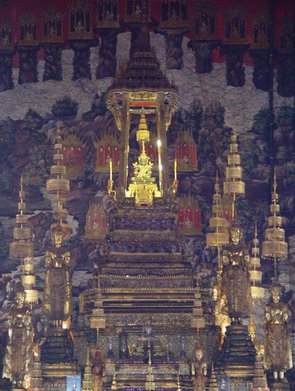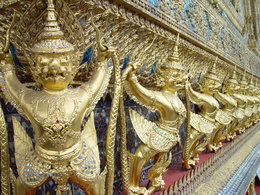Emerald Buddha
|
|
The Emerald Buddha is the palladium of the Kingdom of Thailand, a figurine of the sitting Buddha, made of green jade (rather than emerald), clothed in gold, and about 45 cm tall. It is kept in the Chapel of the Emerald Buddha (Wat Phra Kaew) on the grounds of the Grand Palace in Bangkok.
History
According to legend, the Emerald Buddha was created in India in 43 BCE by Nagasena in the city of Pataliputra (today Patna), but some art historians describe it as belonging to the Chiang Saen Style of the 15th century CE. The legends state that, after remaining in Pataliputra for three hundred years, it was taken to Sri Lanka to save it from a civil war. In 457 King Anuruth of Burma sent a mission to Ceylon to ask for a Buddhist scriptures and the Emerald Buddha, in order to support Buddhism in his country. These requests were granted, but the ship lost its way in a storm during the return voyage and landed in Cambodia. When the Thais captured Angkor Wat, the Emerald Buddha went to Ayutthaya, Kampaengphet, Lao and finally Chiang Rai, where the ruler of the city hid it.
Historical sources indicate that the statue surfaced in northern Thailand in the Lannathai kingdom in 1434. One account of its discovery is as follows: lightning struck a pagoda in a temple in Chiang Rai, after which something became visible under the stucco. The Emerald Buddha was dug out and the people thought the figurine was made from emerald, hence its current name. King Sam Fang Kaen of Lannathai wanted it in his capital, Chiang Mai, but the elephant carrying it insisted on going to Lampang instead, on three separate occasions. This was taken as a divine sign and it stayed in Lampang until 1468, when it was finally moved to Chiang Mai.
In 1552 the Emerald Buddha was brought to Louang Phrabang, the capital of Laos at that time, as the Lao crown prince Setthathirath was invited to become new king of Lannathai. However, he returned home to become king of Laos when his father Photisarath died and took the figurine with him. He later moved it to his new capital Vientiane in 1564.
In 1779, Thai General Phraya Chakri of seized Vientiane and brought the Emerald Buddha to Thonburi. After he became King Rama I of Thailand, the image was moved to its current place in the Wat Phra Kaew on March 22, 1784. It is now kept in the main building of the temple, the Ubosoth.
Gold clothing
The Emerald Buddha itself is simply the jade statue, but it is adorned with garments made of gold. There are three different sets of gold clothing, which are changed by the King of Thailand in a ceremony at the changing of the seasons. The three sets of gold garments correspond to Thailand's hot season, rainy season, and cool season. The two sets of gold clothing not in use at any given time are kept on display in the nearby Pavilion of Regalia, Royal Decorations and Thai Coins on the grounds of the Grand Palace, where the public may view them.
Images
Emerald_buddha2.jpg
| Missing image Dharma_wheel_1.png Dharma wheel Buddhism |
| Culture |
| History |
| List of topics |
| People |
| By region and country |
| Schools and sects |
| Temples |
| Terms and concepts |
| Texts |
| Timeline |



